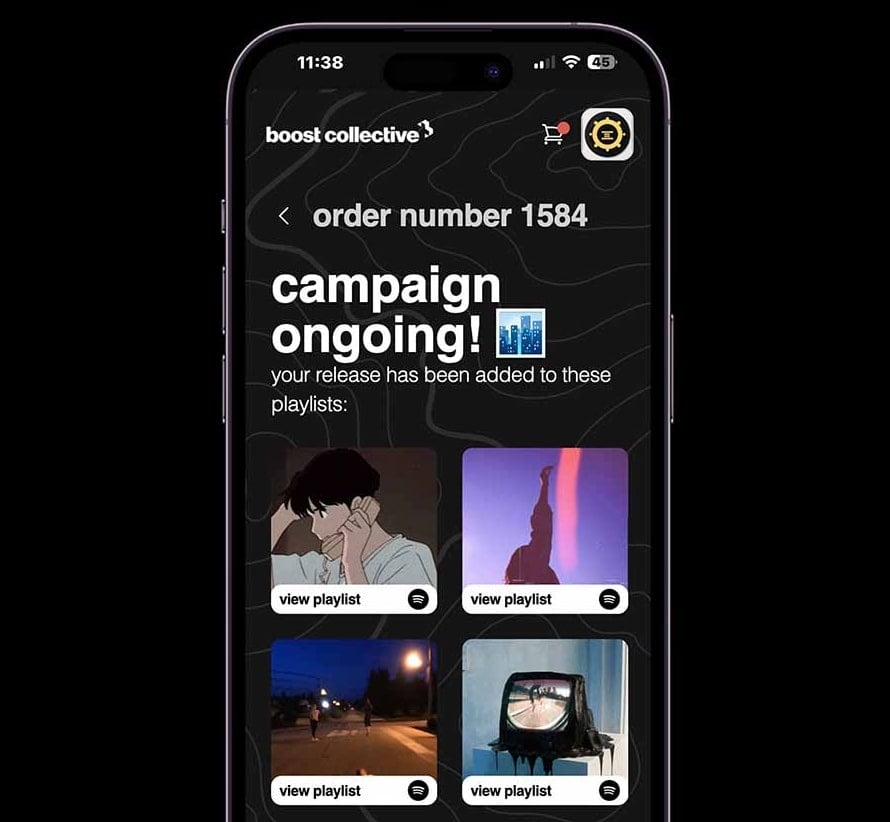Overview

In today's digital age music online and, streaming platforms have become a vital tool for musicians to reach their audience and gain recognition.
However, with so many emerging artists vying for attention, how can you effectively market your music on these platforms?
Introduction
The rise of streaming platforms such as Spotify, Apple Music, and SoundCloud has revolutionized the music industry.
Independent music artists now have the opportunity to reach a global audience without the need for a major record label.
However, successfully promoting your music on these platforms requires a strategic approach and an understanding of the ever-changing music business landscape.
To master effective, music marketing strategies used on streaming platforms, it's essential to utilize various strategies and techniques that will help you stand out from the crowd and connect with your target audience.
In this article, we will explore the seven key steps you need to take to navigate the world of streaming platforms maximize your music's reach, and impact the digital world.
Whether you're an aspiring musician or an established artist, these tips will guide you toward success in the digital music industry.
The Evolving Music Industry Landscape

The music industry landscape has been constantly evolving over the years, shaped by advancements in technology, changing consumer preferences, and the rise of digital platforms.
Here's a brief discussion of some key aspects of the evolving music industry landscape:
-
Digital Transformation: The advent of digital technology has revolutionized the music industry. With the rise of streaming platforms like Spotify, Apple Music, and YouTube, the way people consume music has shifted from physical formats (CDs, vinyl) to digital streaming. This shift has had a profound impact on revenue streams, distribution models, and the overall business structure of the industry.
-
Streaming Dominance: Streaming has become the dominant form of music consumption, surpassing physical sales and digital downloads. The convenience, accessibility, and vast music libraries offered by streaming platforms have attracted millions of subscribers worldwide. However, this shift has also raised concerns about fair compensation for artists and the sustainability of the streaming model.
-
Independent Artists and DIY Culture: The barriers to entry for aspiring musicians have significantly lowered due to affordable recording equipment, online distribution platforms, and social media. Independent artists now can release and promote their music without major label support. This has led to a thriving DIY (do-it-yourself) culture, empowering artists to maintain creative control and build direct relationships with their fan base.
-
Data and Analytics: The availability of data and advanced analytics tools has transformed the way the industry operates. Streaming platforms and social media provide vast amounts of data on listener behavior, preferences, and trends. This data is used by artists, labels, and marketers to make informed decisions regarding content creation, promotion, and tour planning.
-
Live Music and Experiences: As revenue from recorded music has declined, live performances and experiences have become increasingly important for artists and the industry as a whole. Live music events, festivals, and tours have become major sources of income and fan engagement. Artists are also exploring innovative ways to enhance live experiences, such as virtual concerts and augmented reality (AR) integrations.
-
Globalization and Cross-Cultural Influences: The digital era has facilitated the global reach of music, enabling artists from different regions to collaborate and fuse genres, resulting in a more diverse and eclectic musical landscape. Cross-cultural influences and collaborations have become more common, breaking down traditional genre boundaries and appealing to broader audiences.
-
Licensing and Royalties: The complexity of licensing and royalty distribution has been a longstanding challenge in the music industry. With the rise of streaming and digital platforms, there have been ongoing discussions and efforts to improve transparency, ensure fair compensation for artists and songwriters, and address issues like mechanical royalties, publishing rights, and licensing for user-generated content.
Understanding Streaming Platforms

Popular Streaming Platforms
-
Spotify:
-
Spotify is one of the most popular music streaming platforms worldwide. It offers a vast catalog of music from various genres and artists.
-
Features: Spotify provides both free and premium subscription options. With the free version, you can listen to music with occasional ads and some limitations. The premium version offers ad-free listening, higher audio quality, offline playback, and unlimited skips.
-
Personalization: Spotify is known for its personalized playlists and recommendations. It creates playlists like Discover Weekly, Release Radar, and Daily Mixes based on your listening habits and preferences.
-
Social and collaborative features: Spotify allows you to follow friends, share playlists, and collaborate on playlists together. It also integrates with social media platforms, allowing you to share your favorite music with others.
-
-
Apple Music:
-
Apple Music is a music streaming service offered by Apple. It provides a vast library of songs and is popular among Apple device users.
-
Integration with Apple ecosystem: Apple Music is deeply integrated with Apple devices, including iPhones, iPads, Macs, and Apple Watches. It syncs your music library and preferences across devices seamlessly.
-
Features: Apple Music offers a free trial and a paid subscription. The paid subscription provides ad-free streaming, high-quality audio, offline listening, and unlimited skips. It also includes access to exclusive content and original shows hosted by artists.
-
iTunes integration: Apple Music integrates with iTunes, allowing users to import their existing music libraries and merge them with the streaming catalog.
-
Curated playlists and radio: Apple Music offers expertly curated playlists and radio stations across various genres. It also features Beats 1, a 24/7 live radio station with celebrity hosts and exclusive interviews.
-
-
YouTube Music:
-
YouTube Music is a music streaming service developed by YouTube. It combines official songs, music videos, live performances, and covers from various artists.
-
Music video integration: YouTube Music provides access to a vast collection of music videos, making it an excellent platform for music discovery and visual experiences.
-
Features: YouTube Music offers a free ad-supported version and a premium subscription. The premium subscription removes ads, enables background play, and allows offline listening. It also includes access to YouTube Originals and YouTube's extensive video catalog.
-
Recommendations and discovery: YouTube Music utilizes Google's algorithms to recommend personalized playlists, based on your listening history and preferences. It also offers a "Hotlist" section showcasing trending songs and music videos.
-
Integration with Google services: YouTube Music integrates with other Google services, such as Google Assistant and Google Home, making it easy to control and play music across various devices.
-
These platforms offer similar features but have different user interfaces, integrations, and exclusive content. Ultimately, the choice between them depends on personal preferences, the device ecosystem, and the specific features that appeal to individual users.
Understanding Music Streaming Metrics And Analytics

Music streaming metrics and analytics are important tools for artists, record labels, and streaming platforms to measure and understand the performance and popularity of songs and albums.
These metrics provide valuable insights into listener behavior, engagement, and the overall impact of music releases.
Here are some key concepts and terms related to music and streaming services, metrics, and analytics:
-
Streams: Streams refer to the number of times a song or album has been played by listeners. Each time a user listens to a track on a streaming platform, it counts as a stream. The total number of streams helps measure the popularity and reach of a particular piece of music.
-
Playlists: Playlists are curated collections of songs created by either users or streaming platforms. They can have a significant impact on a song's visibility and streaming numbers. Being featured on popular playlists can lead to increased streams and exposure.
-
Monthly Listeners: Monthly listeners represent the number of unique listeners who have streamed an artist's music within a given month. It provides an estimate of an artist's audience size and potential reach.
-
Followers: Followers indicate the number of users who have chosen to follow an artist or a profile on a streaming platform. These followers receive updates about new releases and activities from the artist.
-
Top Lists and Charts: Streaming platforms often feature various top lists and charts, such as the Top 50 or Hot 100, which rank songs based on their popularity and streaming numbers. Artists strive to achieve high positions on these charts as they provide increased visibility and exposure.
-
Skip Rate: Skip rate refers to the percentage of listeners who skip a song before it completes. A high skip rate may indicate that listeners are not engaged with a particular track, while a low skip rate suggests that listeners are enjoying the song.
-
Average Stream Duration: Average stream duration measures the average length of time users spend listening to a particular song. It indicates listener engagement and whether users are listening to a song in its entirety or skipping it early.
-
Demographics: Streaming platforms provide demographic data that offers insights into the age, gender, location, and other characteristics of an artist's listeners. This information can help artists understand their target audience and make informed marketing decisions.
-
Discovery and Recommendations: Streaming platforms employ algorithms to recommend songs and artists to users based on their listening history and preferences. Artists can benefit from understanding how their music is discovered and recommended to new listeners.
-
Revenue and Royalties: Music streaming platforms generate revenue through subscription fees and advertisements. Artists receive royalties based on the number of streams their songs accumulate. Understanding the revenue generated and how it translates into royalties is crucial for artists and labels to track their financial performance.
Analyzing these metrics and analytics can help artists and industry professionals make informed decisions about marketing strategies, release plans master music marketing, touring, and collaborations.
By understanding listener behavior and engagement patterns, artists can optimize their marketing strategy and approach to reach a wider audience and maximize their streaming success.
Building A Strong Online Presence

Creating An Engaging Artist/Band Profile
Creating an engaging artist/band profile involves highlighting your unique qualities, telling your story, and compellingly showcasing your music. Here's a step-by-step guide to help you create an engaging artist/band profile:
-
Introduce Yourself: Begin by providing a brief but captivating introduction to your artist or band. Highlight your genre, influences, and any standout characteristics that set you apart from other musicians. Use descriptive and engaging language to draw the reader in.
-
Tell Your Story: Share the journey that led you to pursue music. Talk about your background, early experiences, and the events that shaped your musical identity. Discuss any significant achievements, challenges, or transformative moments that have influenced your artistic development.
-
Highlight Your Musical Style: Describe your music style in detail, providing insight into the sound, mood, and themes that define your work. Mention any unique elements, blending of genres, or experimental approaches that make your music stand out. You can also include comparisons to well-known artists or bands to give readers a reference point.
-
Discography And Releases: List your discography, including albums, EPs, singles, and collaborations. Provide links or references to where people can find your music, whether it's on streaming platforms, YouTube, Bandcamp, or your website. Highlight any notable achievements, such as chart positions, awards, or critical acclaim.
-
Live Performances: Emphasize your live performances and touring experience. Mention any notable venues, festivals, or cities you've played in. If you have supported or opened for well-known artists, include those details as well. Share memorable anecdotes or stories from your live shows to create a sense of excitement and connection with your audience.
-
Press And Media Coverage: Include notable press and media coverage you have received. This can include interviews, reviews, features, or mentions in magazines, newspapers, blogs, or online publications. Quote snippets from positive reviews or highlight any notable quotes from interviews to build credibility and intrigue.
-
Fan Engagement And Testimonials: Showcase your relationship with your fans by mentioning fan interactions, testimonials, or social media engagement. Highlight any fan-created content, such as cover songs, fan art, or testimonials about how your music has impacted their lives. This helps potential fans connect with your music on a personal level.
-
Social Media And Online Presence: Provide links to your official website, social media profiles, and any other online platforms where fans can connect with you. Include your handles for Instagram, Twitter, Facebook, YouTube, SoundCloud, or any other relevant platforms. Encourage readers to follow, subscribe, or engage with your content.
-
Visual Identity: Use high-quality images, such as professional photos or album artwork, to visually represent your artist/band. Visuals can capture the essence of your music and create an immediate impression. Ensure that the images align with your style, genre, and overall aesthetic.
-
Contact Information And Booking: Include your contact information for inquiries, booking requests, or collaborations. Provide an email address or a dedicated contact form on your website where interested parties can reach out to you directly.
Make it easy for industry professionals, press, or potential collaborators to get in touch.
Remember to tailor your artist/band profile to your target audience and keep it concise, engaging, and true to your unique identity.
Regularly update your profile to reflect new releases, achievements, or developments in your career.
Optimizing Music Metadata And Album Artwork
Optimizing music metadata and album artwork is crucial for organizing and presenting your music collection effectively.
Here are some tips to help you optimize your music metadata and album artwork:
-
Consistent Metadata Format: Ensure that your music files have consistent and accurate metadata. This includes information like artist name, album title, track numbers, genre, release date, and more. Using a standardized format such as ID3 tags for MP3 files will help ensure compatibility across different music players and platforms.
-
Correcting Inaccurate Metadata: Check your music files for any incorrect or missing metadata. You can use specialized software or music management tools to bulk edit and update metadata. Ensure that all the essential information is present and accurately reflects the music tracks.
-
Album Artwork Resolution: Album artwork is an essential part of music metadata. Make sure the artwork is high-resolution (typically around 1400x1400 pixels or higher) to ensure it looks crisp and clear when displayed on various platforms. Use lossless image formats such as PNG or JPEG 2000 to preserve image quality.
-
Consistent Artwork Style: Maintain a consistent style and design for your album artwork to create a cohesive look across your music collection. This can involve using similar typography, color schemes, or themes that reflect your brand or artistic vision.
-
Embedded Artwork: Embed the album artwork directly into the music files to ensure it travels with the music, regardless of where it's played. This way, the artwork will be displayed on various music players and devices that support album art display.
-
File Naming Conventions: Adopt a consistent file naming convention for your music files to make them easily searchable and organized. Include relevant information such as artist name, album title, and track number in the file names.
-
Metadata Tagging Tools: Take advantage of specialized tagging tools or music management software that can automate the process of updating and organizing your music metadata. These tools often have features for batch editing, finding missing metadata, and fetching album artwork from online databases.
-
Online Music Databases: Ensure your music metadata matches popular online music databases like MusicBrainz or Discogs. This will improve the accuracy and consistency of your music collection's information when importing or sharing it across platforms.
-
Backup And Metadata Preservation: Make regular backups of your music library, including the metadata and album artwork. This will protect your collection from accidental loss or corruption and help you easily restore your music library in case of any issues.
By following these tips, you can optimize your music metadata and album artwork, resulting in a well-organized and visually appealing music collection.
Preparing And Releasing Music

Preparing digital marketing and releasing music involves several key steps to ensure a successful launch.
Here's a general guide on how to create music prepare and release your music:
-
Songwriting And Production:
-
Write and compose your songs, ensuring they are well-structured, catchy, and appealing to your target audience.
-
Develop the instrumental arrangements and record high-quality tracks.
-
If needed, collaborate with other musicians, songwriters, or producers to enhance your music.
-
-
Pre-Production:
-
Plan and organize the recording process, including scheduling studio time, hiring session musicians (if necessary), and preparing any necessary samples or sounds.
-
Rehearse your songs thoroughly before entering the studio to ensure a polished performance.
-
Consider working with a professional audio engineer or producer to enhance the overall sound quality.
-
-
Recording And Mixing:
-
Book a recording studio or set up your own home studio with quality equipment.
-
Record each instrument and vocal track separately for better control during the mixing process.
-
After recording, the audio tracks need to be mixed, balancing the levels, adding effects, and creating a cohesive sound.
-
-
Mastering:
-
Mastering is the final step in the audio production process. It involves fine-tuning the overall sound of your music, making it sound consistent across different devices and platforms.
-
Hire a professional mastering engineer who can optimize the audio for various listening environments and ensure it meets industry standards.
-
-
Artwork And Design:
-
Create or commission compelling artwork that represents your music visually. This includes album covers, promotional photos, and social media visuals.
-
Ensure that the artwork aligns with your artistic vision and grabs the attention of your target audience.
-
-
Metadata And Distribution:
-
Prepare the necessary metadata for your music, including song titles, artist name, genre, release date, and copyright information.
-
Choose a digital distribution platform (e.g., TuneCore, CD Baby, DistroKid) to distribute your music to online stores and streaming platforms like Spotify, Apple Music, and Amazon.
-
Follow the platform's guidelines for submitting your music and ensure all information is accurate and consistent across platforms.
-
-
Promotion And Marketing:
-
Develop a comprehensive marketing plan that includes social media promotion, press releases, music video production, and live performances.
-
Utilize social media platforms, websites, and email newsletters to engage with your audience and build a fan base.
-
Seek opportunities for media coverage, interviews, and collaborations to increase your exposure.
-
-
Release And Distribution:
-
Set a release date for your music, considering factors like promotional efforts and availability on streaming platforms.
-
Coordinate with your chosen digital distribution platform to ensure your music is delivered to online stores and streaming platforms on time.
-
Plan a release strategy, which could involve releasing singles, EPs, or full albums, depending on your goals and resources.
-
Remember, music promotion and release strategies can vary depending on your genre, target audience, and personal goals.
It's important to adapt these steps to suit your specific needs and budget.
Additionally, consider seeking guidance from industry professionals or connecting with other musicians for further advice and support.
Promoting Music On Streaming Platforms
Promoting music on streaming platforms is essential for gaining exposure to new fans and reaching a wider audience.
Here are some strategies to help you promote your music on social media platforms effectively:
-
High-Quality Production: Ensure your music is professionally recorded, mixed, and mastered. Quality production is crucial for grabbing the attention of listeners on streaming platforms.
-
Create An Engaging Profile: Optimize your artist profile on streaming platforms like Spotify, Apple Music, or SoundCloud. Use high-resolution images, write a compelling biography, and include links to your social media accounts and website.
-
Release Singles And EPs: Instead of releasing a full album at once, consider releasing singles or EPs (extended plays) to maintain a consistent presence on streaming platforms. This allows you to generate more excitement and anticipation for your music.
-
Collaborate With Influencers: Collaborating with established artists or social media influencers can help expand your reach. Seek out collaborations that align with your music style and target audience to tap into their existing fan base.
-
Playlist Placement: Submit your music to relevant playlists curated by streaming platforms or influential curators. Getting featured on popular playlists can significantly increase your exposure and attract new listeners.
-
Social Media Promotion: Leverage social media platforms to connect with your fans and promote your music. Regularly post engaging content, behind-the-scenes footage, teasers, and updates about your music releases. Encourage your followers to stream your music on streaming platforms.
-
Engage With Your Audience: Respond to comments and messages from your listeners on streaming platforms and social media. Engaging with your audience builds a loyal fan base and creates a personal connection, increasing the chances of them sharing your music.
-
Utilize YouTube And Music Videos: Create visually appealing music videos and upload them to YouTube. YouTube is a powerful platform for music discovery, and having captivating videos can attract new listeners to your music.
-
Collaborate With Bloggers And Music Reviewers: Reach out to music bloggers, online magazines, and music reviewers who cover your genre. Request reviews, interviews, or features on their platforms to gain exposure and credibility.
-
Live Performances And Touring: Perform live shows, whether it's local gigs, festivals, or tours. Live performances allow you to connect with fans on a personal level and convert them into loyal listeners who will continue streaming your music.
-
Paid Advertising: Consider investing in targeted advertising campaigns on streaming platforms or social media to reach a broader audience. These platforms often offer tools to help you target specific demographics and music preferences.
Remember, promoting your music on streaming platforms requires consistency, patience, and perseverance.
It's important to continuously release new music, engage with your audience, and adapt your promotional email marketing strategies based on the feedback and data you receive.

The Wrap-Up
Mastering effective music marketing tactics on streaming platforms requires a combination of strategy, creativity, and persistence.
By optimizing your metadata, collaborating with influencers, engaging with your audience, leveraging your social media channels, utilizing data analytics, and exploring paid advertising options, you can enhance your visibility, gain more streams, and ultimately build a successful music career.
Stay updated with the latest trends, adapt your strategies accordingly, and never underestimate the power of a captivating melody combined with a well-executed music marketing strategy and plan.
